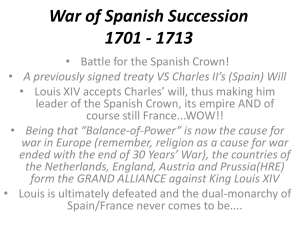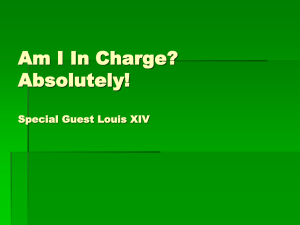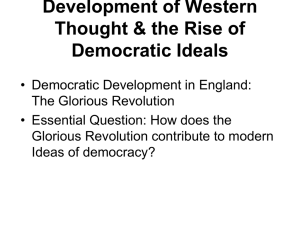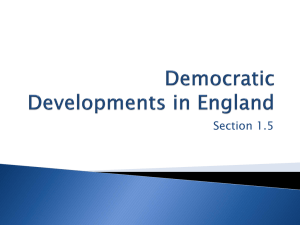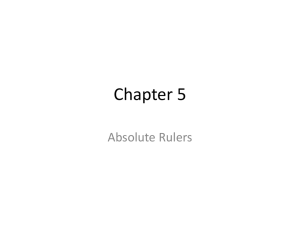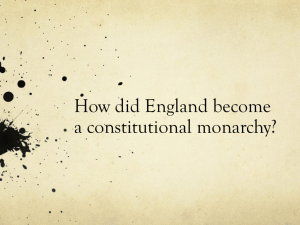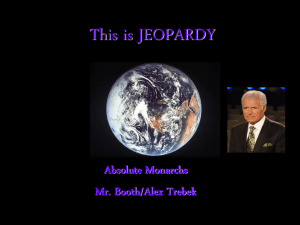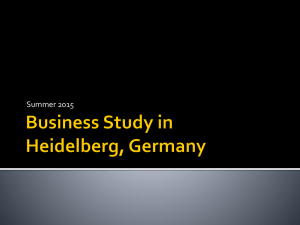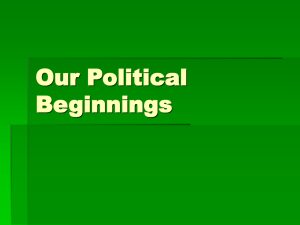File
advertisement
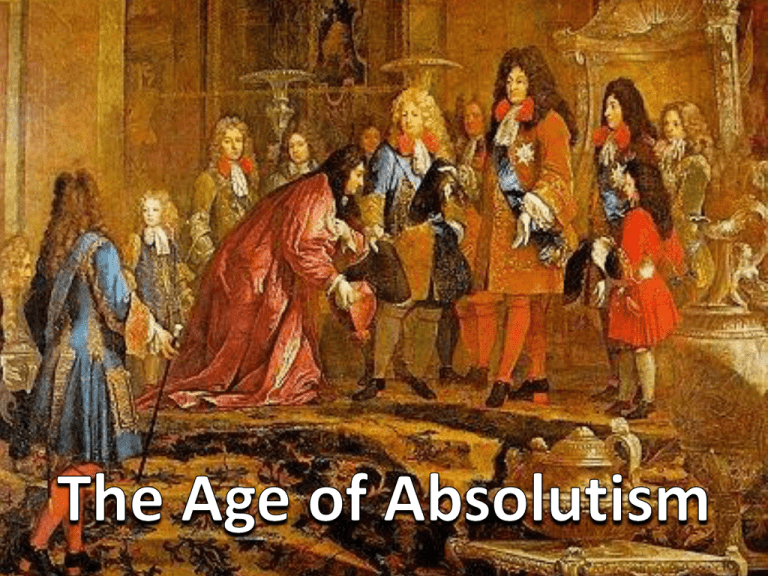
• European monarchs created even more powerful nations in the 1500s & 1600s – Built up state bureaucracies & equipped powerful armies – Ensured loyalty to the crown & used their growing resources for bold ventures home & overseas • Spain, Portugal, and The Netherlands quickly took the lead in obtaining overseas empires Extending Spanish Power • In the 1500’s, wealth from the Americas helped make Spain the most powerful state in Europe • Spain emerged as the first modern European power • Under Isabella & Ferdinand, Spain expelled the last Muslim rulers and enforced religious unity – Financed Columbus’s voyage to the Americas Charles V • Charles V ruled an even larger empire from 1519-1556 – Grandson of Ferdinand & Isabella – Also heir to the Hapsburgs, the Austrian rulers of the Holy Roman Empire & the Netherlands • Ruling two Empires involved Charles in constant warfare – Continued a long struggle with France over rival claims in Italy – Devout Catholic, fought to suppress the Protestant Reformation • Biggest enemy was the Ottoman Empire – The Ottomans occupied much of Hungary and their forces advanced to Austria • Hapsburg Empire was too scattered & diverse for only one person to rule • Exhausted Charles V, gave up his titles & entered a monastery in 1556 • Divided his Empire: – Gave Hapsburg land in central Europe to his brother Ferdinand, who became Holy Roman Emperor – Gave Spain, the Netherlands, southern Italy & huge Spanish overseas Empire to 29 year old son Philip Philip II • Hard working like his father, reigned from 1556-1598 and wanted to expand Spanish influence, strengthening the Catholic Church & make his own power absolute • Devoted much time to government work and further centralized royal power, making all parts of the government responsible to him • Became an absolute monarch, a ruler with complete authority over the government & the lives of the people • Believed he ruled by divine right, authority to rule came directly from God • Saw himself as the guardian of the Catholic Church • Used the Inquisition to turn on Protestants & other heretics • Wars of Philip II – Fought many wars as he advanced Spanish Catholic power throughout the world – Battled Protestant rebels in the Netherlands • At the time the region was made of 17 provinces that are today: Belgium, The Netherlands & Luxemburg • Richest part of Philip’s empire – Both Protestant & Catholic subjects opposed high taxes & the threats to their traditional self-government rule – Riots against the Inquisitor sparked uprisings in the Netherlands – In 1581, the large North Province became known as the Dutch Netherlands • Gained official recognition in 1648 • Southern provinces remained part of the Spanish Empire Fights with Elizabeth • In 1580, Philip saw Elizabeth as his chief Protestant enemy • Elizabeth supported the Dutch against Spain – Encouraged English captains, Sea Dogs, to plunder Spanish treasure ships – Francis Drake, looted Spanish cities in the Americas – Elizabeth made him a knight, Philip was outraged • To end English attacks and subdue the Dutch, Philip prepared a huge Armada, or fleet, to carry a Spanish invasion to England • In 1588, the Armada sailed with more than 130 ships, 20,000 men, & 2400 pieces of artillery – “Strange freak of weather” favored the other side – Big Spanish ships took losses from the lighter, faster English ships • In the 1600s & 1700s, Dutch, English, & French fleets challenged & surprised Spanish power in Europe & around the world Economic Decline • In the 1600s, Spanish power slowly declined • Successors after Philip II were less able rulers then he • Costly overseas wars drained wealth out of Spain, almost as fast as it came in • Treasure from the Americas led Spain to neglect farming & commerce • The government heavily taxed the small middle class, weakening a group that normally supported royal power – The expulsion of Muslims & Jews from Spain deprived the economy of many skilled artisans & merchants – American gold & silver led to soaring inflation • Eventually, France replaced Spain as the most powerful European nation France under Louis XIV Rebuilding France • From the 1560’s to the 1590’s, religious wars between the Huguenots (French Protestants) & the Catholic majority tore France apart – Two groups, the Catholic Guises & the Protestant Bourbons committed terrible atrocities against each other – On St. Bartholomew's day, August 24, 1572, Huguenot & Catholic nobles attended the same wedding, violence erupted, led to a massacre of 3,000 Huguenots • Next few days, thousands more were slaughtered – St. Bartholomew's Day, for many symbolized the breakdown of order in France Henry IV • 1589, a Bourbon prince & Huguenot leader, Henry Navarre, inherited the French throne • Knew he would face problems ruling a largely Catholic land, he converted to Catholicism • In 1598 he granted the Edict of Nantes – Gave religious toleration to the Huguenots • Wanted peace for all – Administered justice, improved roads, built bridges & revived agriculture • Led the foundation of royal Absolutism Richelieu • Henry IV, fell victim to an assassin in 1610, his 9 year old son Louis XIII, inherited the throne • 1624, Louis XIII appointed Cardinal Armand Richelieu as his chief minister – Strengthened the central government • Richelieu destroyed the power of the nobles & the Huguenots – Two groups that did not bow down to royal authority • Defeated the private armies of the nobles & destroyed their castles • Took away the nobles independence but also tied them to the King by giving them high posts at court or in the Royal Army • Richelieu handpicked his successor, Cardinal Jules Mazarin – When 5 year old Louis XIV inherited the throne, Mazarin was in place to serve at the young King’s Chief Minister From Boy King to Sun King • Soon after Louis XIV became King, disorder again swept in France • In an uprising called the Fronde, nobles & merchants, peasants, & the urban poor rebelled – All for their own reasons • The rioters drove the young King out of his palace • Mazarin died in 1661 and Louis resolved to take over the government himself I AM the State • Louis believed in Divine Right, like his great-grandfather, Philip II • He took the sun as the symbol of his power – Like the sun stands as the center of the Universe, Louis (the Sun King) was the center of the French nation • Louie is quoted in saying, “L’etat, c’est moi”- “I am the State” • Bishop Jacques Bossuet, tutor to Louis son, summed the theory of divine right, in his Universal History – Stated that the King was God’s representative on Earth • Louis XIV, never called a meeting of the Estates General, representatives from all 3 Estates: Clergy, Nobles & Townspeople – The Estates General did not meet between 1614-1789 – Unlike the English Parliament, the Estates General played no role in checking royal power • The Business of Government – Followed the policies of Richelieu – Louis XIV expanded the bureaucracy & appointed intendants, royal officials who collected taxes, recruited soldiers & carried out the policies of provinces • Jobs with in the office of intendant & other gov’t jobs went to wealthy middle class men – Louis cemented ties between the middle class & the monarchy – The French Army became the strongest in Europe • The State paid, fed, trained & supplied up to 30,000 soldiers • Louis used this highly disciplined army to enforce his policies at home & abroad • Colbert & the French Economy – Louis found an expert organizer, to be his chief finance minister: Jean Baptiste Colbert • Followed mercantilist policies, to bolster the economy & promote trade • Had new lands cleared for farming • Put high tariffs on goods, to protect French manufacturers – Louis XIV was still short for cash • Huge costs of court & foreign wars The Splendor of Versailles • In the countryside of Paris Louis XIV turned a royal hunting lodge into the immense palace of Versailles – Spared no expense – Halls & salons displayed the finest paintings & statues, glittering chandlers & mirrors – Royal gardens had millions of flowers, plants, & trees • Versailles became the perfect symbol of the Sun King’s wealth & power • As both the King’s home & the seat of gov’t, it housed at least 10,000 people, from nobles & officials to servants • Ceremonies of Daily Life – Louis XIV perfected elaborate ceremonies that emphasized his own importance – Each day began with, “ la leve’e”, the King’s rising • High ranking nobles competed for the honor of holding the royal was basin or handing the King his diamond buckle shoes • Wives of nobles vied to attend upon women of the royal family – Such ceremonies served another purpose • French nobles were descendants of the feudal lords who held power in the medieval times • If they were at their estates, the nobles threatened the power of the monarchy • By luring the nobles to Versailles, Louis turned them into courtiers, angling for privileged, rather than warriors battling for power • Louis carefully protected their prestige & left them free from paying taxes • Culture – The King sponsored musical events and commissioned plays by the best writers – The age of Louis XIV was the classical age of French drama – In painting, music, architecture & decorative arts, French styles became the model for all of Europe • A new form of dance drama, ballet, gained its popularity at the French court • Louis sponsored the French Academics, which set high standards for both arts & sciences Successes & Failures • Louis XIV ruled France for 72 years, longer than any other monarch • During that time French culture, manners & customs replaced those of Renaissance Italy, as the standard for Europe taste • In both foreign & domestic affairs, many of Louis’s policies were costly failures The Wars of Louis XIV • Louis poured vast resources into wars to expand French borders & dominate Europe • At first he did gain some territory, but his later wars were disastrous – Rival rulers joined forces to check French ambitions – Led by the Dutch & English, these alliances fought to maintain the balance of power, a distribution of military & economic power that would prevent any nation from dominating Europe • In 1700, Louis grandson, Philip V inherited the throne of Spain • Louis declared that France & Spain “must regard themselves as one” • Neighboring powers, led by England, were determined to prevent this union • The war of the Spanish Succession dragged on until 1713, when an exhausted France signed the Treaty of Utrect – Philip remained on the Spanish throne, but France agreed never to unite the two crowns • Persecution of the Huguenots – Louis saw the Protestant minority as a threat to religious & political unity – In 1685, he revoked the Edict of Nantes • More than 100,000 Huguenots fled France, fearing persecution – Huguenots, had been among the most hardworking and prosperous of Louis subjects • Their loss was a serious blow to the French economy, just as the expulsion of Muslims & Jews hurt Spain Triumph of Parliament in England The Tudors & Parliament • From 1485 to 1603, England was ruled by the Tudor dynasty • Although the Tudors believed in divine right, they recognized the value of good relations with Parliament – When Henry VIII broke away from the Roman Catholic Church, he turned to Parliament to legalize his actions, which approved the Act of Supremacy • Parliament was awarded land • A constant need for money also led Henry to consult Parliament frequently – Henry used many funds fighting overseas wars • To levy new taxes, the King had to seek approval from Parliament – Members of Parliament tended to vote as Henry’s agents instructed, but were still consulted on important matters • Elizabeth consulted Parliament, but controlled it as well – Her advisers conveyed Elizabeth’s wishes to Parliament & forbade discussion of foreign policy or the Queen’s marriage The Early Stuarts • In 1603, after a 45-year reign, Elizabeth died without a direct heir • The throne passed to her relatives the Stuarts, the ruling family of Scotland • The Stuarts were neither as popular as the Tudors nor as skilled in dealing with Parliament • Stuarts inherited problems that Henry & Elizabeth had long suppressed – The result was, a “Century of Revolution”, that pitted the Stuart monarchs against Parliament The Royal Challenge • James I (England) & IV (Scotland), was the first Stuart monarch & agreed to rule according to English laws & customs • Soon he was lecturing Parliament about divine right – Repeatedly, clashed with Parliament over money & foreign policy – He needed funds to finance his lavish court & wage wars • Members wanted to discuss foreign policy before voting funds & James dissolved Parliament & collected taxes on his own • Leaders in the House of Commons fiercely resisted the King’s claim to absolute power • Parliament Responds – Charles I inherited the throne in 1625 and like his father, behaved like an absolute monarch – He imprisoned foes without trial & squeezed the nation for money – In 1628, his need to raise taxes forced Charles to summon Parliament – Before voting any funds, Parliament insisted that Charles sign the Petition of Right, which prohibited the King from raising taxes with the consent of Parliament or imprisoning anyone without just cause • Charles did sign the Petition, but then he dissolved Parliament in 1629 – For 11 years, he ignored the Petition & ruled without Parliament – During this time he created bitter enemies • In 1637, Charles & Archbishop Laud tried to impose the Anglican prayer book on Scotland – The Calvinist Scots revolted • To get funds to support the Scottish rebellion, Charles finally had to summon Parliament in 1640 – When it met Parliament launched its own revolt • The Long Parliament – The Parliament that Charles I summoned became known as the, “Long Parliament” because it lasted on & off until 1653 – Its actions triggered the greatest political revolution in history – Parliament tried & executed the Kings chief Ministers, including Archbishop Laud – Members of Parliament declared that Parliament could not be dissolved without consent – Charles lashed back, in 1642 he led troops into the House of Commons to arrest its most radical leaders • They escaped through a back door & soon raised their own army The English Civil War • The Civil War would last from 1642-1649 – Like the Fronde that occurred about the same time in France, it posed a major challenge to absolute monarchs – In France royal power won – In England the revolutionaries triumphed • Cavaliers & Roundheads – At first the odds seemed in favor of the Cavaliers or supporters of Charles I – Many Cavaliers were nobles, were well trained in dueling & warfare, also expected a quick victory – The Roundheads were composed of country gentry, town dwelling manufacturers & Puritan clergy – They were called Roundheads because their hair was cut close around their heads – The Roundheads found a leader of genius in Oliver Cromwell, a puritan member and skilled general • Organized the “New Model Army” for Parliament – Cromwell’s army defeated the Cavaliers in a series of diverse battles • By 1647, the King was in the hands of Parliament forces • Execution of a King – Parliament set up a court to put the King on trial – Found him guilty & condemned him to death, “As a tyrant, traitor, murder & public enemy” – In January 1649, the King was executed by ax – Execution sent shock waves throughout Europe, for the first time a King was tried & executed by his own people – Sent a signal that no King could claim absolute power & ignore Parliament The Kingless Decade • After the death of Charles I, the House of Commons abolished the monarchy, the House of Lords and the Church of England • Declared England a Republic, known as the Commonwealth, under the leadership of Oliver Cromwell • Rebels in Ireland – The new Republic faced many problems – Supporters of Charles II, the uncrowned heir to the throne, attacked England by way of Ireland & Scotland – Cromwell led forces into Ireland to crush the uprising • Then took stern measure against the Irish Catholic Majority • In 1652 Parliament passed a law exiling most Catholics to barren land in the west of Ireland • The Levellers – Fighting began with in the Commonwealth – The Levellers thought that the poor men should have as much say in gov’t as the gentry, lawyers, & other citizens – Such ideas horrified the gentry, who dominated Parliament – Cromwell & his generals suppressed the Levellers and other radical groups that threatened property ownership – As challenges grew, Cromwell took the title of Lord Protector in 1653 • From then on he ruled through the Army Life in the Commonwealth • In the 1650’s laws were made so that Sunday was a day set aside for religious observance • Theaters and taverns were closed, dancing was banned • Puritans felt every Christian rich & poor must be able to read the Bible The End of the Commonwealth • Soon after Cromwell’s death in 1858, the Puritans lost their grip on England • Many people were tired of military rule & strict Puritan ways • In 1660, a newly elected Parliament invited Charles II to return to England from exile • The Puritan experiment ended with the restoration of the monarchy – Puritan ideas lasted and played an important role in shaping the U.S. The Stuarts Restored • Young Charles II was a popular ruler • He reopened theaters & taverns and ruled a lively court, like Louis XIV • Restored the Church of England & tolerated other Protestants such as: – Presbyterians, Quakers & Baptists • Accepted the Petition of Right but shared his father’s belief in Absolute Monarchy, as well as sympathized with Catholics • Charles’s brother , James II inherited the throne in 1685 • James flaunted his Catholic faith and angered his subjects by appointing Catholics to high positions • Afraid that James would restore the Holy Roman Catholic church, in 1688 Parliament leaders invited James’s Protestant daughter Mary & her Dutch Protestant husband William III, to rule England The Glorious Revolution • William & Mary landed in England with their army in late 1688 – James II fled to France • This bloodless overthrow of a King became known as the Glorious Revolution • Before they could be crowned William & Mary had to accept several acts passed by Parliament that became known as the English Bill of Rights • Limits on Royal Power – The Bill of Rights ensured the superiority of Parliament over the monarchy • It required the monarch to summon Parliament regularly & gave the House of Commons the “power of the purse” A King or Queen could no longer interfere in Parliamentary debates or suspend laws • The Bill also barred any Catholic from sitting on the throne – England became a limited monarchy, a gov’t in which a constitution or legislative body limits the monarch’s powers – The Bill of Rights formally restated the traditional rights of English citizens, such as a trial by jury • It abolished excessive fines & cruel or unjust punishments • It affirmed the principle of habeas corpus, no person could be held in prison with out first being charged with a specific crime Rise of Austria & Prussia The Thirty Years’ War • The French philosopher Voltaire noted that, by early modern times, the Holy Roman Empire was neither holy, not Roman, nor an Empire • It was a patchwork of several hundred small, separate states that paid little need to the emperor • Religion further divided the German states – The north was largely Protestant, while the south of Catholic The War Begins • The war had both religious & political causes • Began as a local conflict in Bohemia (present-day Czech Republic) – Ferdinand, the Hapsburg King, sought to suppress Protestants & to assert royal power over local nobles • In May 1618, rebellious Protestant noblemen tossed two royal officials out of a castle window in Prague • The act signaled a revolt that Ferdinand suppressed • Ferdinand had the support of Spain, Poland & other Catholic states – At first Ferdinand defeated the Bohemians & their Protestant allies – Protestant powers such as the Netherlands & Sweden sent troops to Germany – 1/3 of the German population died in the Thirty Years War • Peace at Last – In 1648, a series of treaties, The Peace of Westphalia was passed – Since so many powers has been involved in the conflict, the war ended with general European peace & an attempt to settle other international problems as well – France gained territory on both its Spanish & German frontiers – The Hapsburgs had to accept almost total independence of all the princes of all the princes, of the Holy Roman Empire – The Netherlands & Switzerland became independent states – Germany was left divided into more than 360 states • Still formally acknowledged the leadership of the Holy Roman Emperor • Each state had its own gov’t, coinage, state church, armed forces & foreign policies – Germany remained fragmented for another 200 years Hapsburg Austria • Weakened by war the Hapsburgs wanted to create a strong united state • Expanded their land by adding Bohemia, Hungary, & parts of Poland & Italy • Unity & Diversity – Was difficult to unite these lands – Divided by geography, and the people had different cultures – In the 1700s the Hapsburg’s empire included: Germans, Magyars, Slavs & others • People spoke many languages including: Czech, Hungarian, Polish & Italian – Hapsburgs had some control over the people • Sent German-speaking officials to Bohemia & Hungary – The Hapsburg empire never developed a centralized system like that of France Prussia • Emerged as a Protestant power • In the 1600s, the Hohenzollern family ruled scattered lands across northern Germany – After Peace of Westphalia, Hohenzollern rulers united their lands by taking over the states between them • Imposed royal power on all subjects & reduced the independence of their nobles • Prussia formed an efficient bureaucracy & very well trained army • Frederick II, used Prussian military well, stealing Silesia from Austria, his victories gave him the name Frederick the Great Keeping the Balance of Power • By 1750, the great powers of Europe included: Austria, Prussia, France, England & Russia – Formed various alliances to maintain the balance of power – The powers would often team up with one power to check another Absolute Monarchy in Russia Peter the Great • Was 10 years old when he came to the throne, but did not control the gov’t • Was not well educated but was immensely curious – Enjoyed learning in the “German Quarter”, the Moscow suburb, where many Dutch, Scottish, English & other foreign artisans & soldiers lived – Heard of the advanced technology that was helping Western European monarchs forge powerful empires • Journey to the West – In 1697, Peter set out to study Western technology for himself – Spent hours walking the streets of European cities • Studied the manners & homes of the people • Visited factories & art galleries • Disguised in shabby clothes and worked as a carpenter in a Dutch Shipyard • In England, Peter was impressed with Parliament – Returned to Russia and brought back a group of technical experts, teachers, soldiers & nobles – Began to reshape Russia but convincing fellow Russians to modernize was difficult • Autocrat & Reformer – Peter was determined to centralize Royal Power – Brought all Russians under his control, including the Russian Orthodox Church – Under Peter, serfdom spread in Russia, long after it died out in Western Europe – Forced some serfs to become soldiers or labor on roads, canals & other gov’t projects – Using autocratic methods, Peter pushed through social & economic reforms • Imported western technology, improved education, simplified the Russian alphabet & set up schools for the study of Math, Science, & Engineering – To pay for reforms he adopted mercantilist policies & encouraged exports – After returning from the west, Peter insisted that nobleman shave their beards & replace their oldfashioned robes with Western European clothes – Peter had no mercy for those who resisted the new order • When elite palace guards revolted he had over 1,000 tortured & executed • To set an example, he left their rotting corpses outside the palace walls for months Russian Expansion • Peter worked to build Russian military power • Created the largest standing army in Europe and set out to extend Russian borders • Search for Warm-Water Ports – In 1700, Peter began a long war against Sweden, Russia’s northwest neighbor, that dominated the Baltic region – Peter pushed the Swedes back & won land along the Baltic • Baltic seaports were frozen in the winter – Peter turned south, seeking warm-water power that would allow Russia to trade with the west all year long • The nearest warm-water coast was that of the Black Sea • Peter fought the Ottoman Turks to recover Russian lands, north of the Black Sea • Peter failed but later Catherine the Great succeeded • Peter’s City – The biggest symbol of Peter’s want for a modern Russia was his new capital city, “St. Petersburg”, seeking to open, “a window to the West” – Located the city on the shores of the swampy Neva River, near the Baltic coast • Peter’s Legacy – When Peter died in 1725 he left a mixed legacy – He expanded Russian territory, gained ports on the Baltic Sea, & created a mighty army – However, when he died the nobles ignored his policy of service to the state Catherine the Great • Peter’s immediate successors were ineffective • A German princess by birth came to Russia at the age of 15 to wed the heir to the Russian throne • She learned Russian, embraced the Russian Orthodox faith & won the loyalty of the people • In 1762, her mentally unstable Czar Peter III, was murder by a group of Russian army officers – With their support she ascended to the Russian throne • Catherine proved to be an efficient, energetic empress • She reorganized the gov’t and embraced Western ideas – Embraced the French language and arts – Also was a serious student of the French thinkers, who led the movement known as the Enlightenment • Catherine could be ruthless – Granted Russian nobles rights, such as the exemption from taxes and let them increase the suppression of the peasants – When peasants rebelled against the harsh burdens of serfdom, Catherine took firm action to repress them • Catherine was determined to expand Russian’s borders • After a war with the Ottoman empire, she achieved the Russian dream of a warm-water port on the Black Sea – Also seized land from neighboring Poland • Partition of Poland – Poland, once a great power, was unable to centralize power – The divided gov’t wasn’t prepared to stand up to its strong neighbors: Russia, Prussia & Austria – In the 1770s, Catherine the Great, Frederick the Great & Emperor Joseph of Austria, eyed Poland – Poland was partitioned in 1770s then twice in the 1790s – By the time Austria, Prussia, & Russia had taken their final slices in 1795, the independent Kingdom of Poland vanished from the map • Not until 1918 would a free polish state reappear
